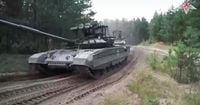Russia and Belarus have launched their long-anticipated joint military exercises, Zapad-2025, amid heightened regional tensions and intense scrutiny from NATO and neighboring states. The drills, which began on September 12 and are scheduled to run through September 16, mark the first strategic-level war games between the two countries since Russia’s full-scale invasion of Ukraine in 2022. The exercises are taking place across a wide swath of territory, including Belarus’s Vitebsk, Minsk, and Grodno oblasts, the city of Barysau northeast of Minsk, and extending into Russia’s Moscow and Leningrad military districts, the Kaliningrad exclave, the Arctic, and the Baltic and Barents seas.
This year’s Zapad—meaning “West” in Russian—comes at a particularly fraught moment. The region was already on edge after Russian drones violated Polish airspace just days before the drills began, prompting Warsaw and its NATO allies to scramble air and ground defenses. According to the Institute for the Study of War (ISW), these incursions were likely intended to probe NATO’s response capabilities, with the alliance swiftly launching the Eastern Sentry operation to reinforce its eastern flank. NATO Secretary General Mark Rutte described Russia’s behavior toward Poland as “reckless” and “deeply dangerous,” emphasizing that “what affects one Ally affects us all.”
While the official purpose of Zapad-2025 is to simulate the repulsion of an enemy attack, the subtext is clear: Russia and Belarus want the world to know they remain a formidable military partnership. “The purpose is for [Russian President Vladimir] Putin to try to show that he is still strong, that the war in Ukraine hasn't really affected them,” retired US Air Force Lieutenant General Lance Landrum, now a senior fellow at the Center for European Policy Analysis (CEPA), told RFE/RL. Landrum added, “This is a display for nations and world media as part of their influence campaign.”
Yet, the scale of this year’s drills is notably diminished compared to previous iterations. Belarusian defense officials initially projected 13,000 troops would participate, but that number was halved in May, with estimates settling around 7,000 to 8,000 personnel—about 2,000 of whom are Russian. Lithuanian intelligence, however, suggested the total number of troops involved across all locations could be as high as 30,000, though only 8,000 would actually be on Belarusian soil. This is a far cry from the estimated 200,000 soldiers that took part in Zapad-2021, reflecting the ongoing strain on Russia’s military resources after three and a half years of relentless combat in Ukraine, which has reportedly cost Moscow over one million casualties.
The exercises are being conducted in two main stages, according to Belarusian Chief of the General Staff Major General Pavel Muraveiko. The first phase focuses on air and ground defense operations, while the second centers on clearing territory of enemy forces and launching counteroffensive maneuvers. Most of the action is concentrated at the 227th Combined Arms Training Ground near Barysaw, but there are also practical tasks being carried out by small units near Belarus’s borders with Poland and Lithuania—an area that has drawn particular concern from neighboring states.
For Ukraine, Latvia, Lithuania, and Poland, the drills are not just routine military theater. They evoke memories of Zapad-2021, when the exercises were used in part to mask the movement of Russian troops into Belarus ahead of the February 2022 invasion of Ukraine. A NATO spokesperson told RFE/RL that the alliance is “monitoring Russian military activity closely” and called on “Russia and Belarus to act in a predictable and transparent manner in line with their international commitments.” However, the spokesperson also noted, “We do not see any immediate military threat against any member.”
Transparency, or the lack thereof, remains a sticking point. “The Kremlin has consistently demonstrated a lack of transparency, including with regard to the size and scope of its exercises,” the NATO spokesperson said. “It has a known history of using military exercises to pursue coercive policies.”
One particularly sensitive aspect of Zapad-2025 is its focus on nuclear weapons planning. Russian officials have said the drills will practice decision-making around the use of Russian nuclear weapons and nuclear-capable intermediate-range missiles, which Moscow has promised to supply to Minsk. Although there are no plans for the physical deployment of these weapons during the exercises, Belarusian Defense Minister Viktor Khrenin has stated that troops will practice “planning the use of” Russian nuclear arms. Belarusian President Aleksandr Lukashenko revealed in December that his country now hosts “several dozen” Russian tactical nuclear weapons, following a treaty signed with Putin that places Belarus under Russia’s nuclear umbrella.
Notably, officials in both Moscow and Minsk have recently softened their rhetoric regarding the drills’ intended message to the West. In the days leading up to Zapad-2025, Belarusian Security Council Secretary Lieutenant General Alexander Volfovich insisted the exercises are “purely defensive in nature” and that they have been moved “deep inside” Belarus, away from state borders. Kremlin spokesperson Dmitry Peskov echoed this, stating, “The Zapad-2025 exercises are not aimed against anyone,” though he emphasized the need for Russia and Belarus to practice force integration. These comments appear to be a deliberate walk-back from earlier, more aggressive statements, likely in response to NATO’s robust reaction to the drone incident over Poland.
Poland, for its part, took no chances, announcing the indefinite closure of its border with Belarus on September 9, just days before the exercises began. Traffic surged at the crossing points in the lead-up to the closure, and Polish authorities were seen installing barbed wire along the frontier. Belarus responded by pledging to keep its own border checkpoints open and offered to increase traffic through its crossings with Latvia and Lithuania. Russian Foreign Ministry spokesperson Maria Zakharova accused Poland of ignoring the fact that Russia and Belarus had moved the exercises away from the border and reduced the number of troops and equipment involved as a gesture of goodwill. Belarus also invited observers from the Organization for Security and Cooperation in Europe (OSCE), including Poland, to monitor the drills.
Amid all this, Belarusian President Lukashenko has made overtures toward the West, releasing 52 political prisoners of various nationalities on the eve of the exercises and holding a phone call with former US President Donald Trump in August. Trump described Lukashenko as a “highly respected President” in a social media post. Ryhor Astapenia, director of the Belarus Initiative at Chatham House, observed, “If these exercises proceed in a dull and transparent manner, they will likely pave the way for further dialogue.”
As Zapad-2025 unfolds, it stands as both a reminder of the region’s volatility and a barometer of Russia and Belarus’s evolving relationship with NATO and the West. While the drills are smaller and their tone more subdued than in years past, the underlying message of strength and readiness is unmistakable. For now, the world watches—warily, but with hope that saber-rattling won’t give way to something far more dangerous.


